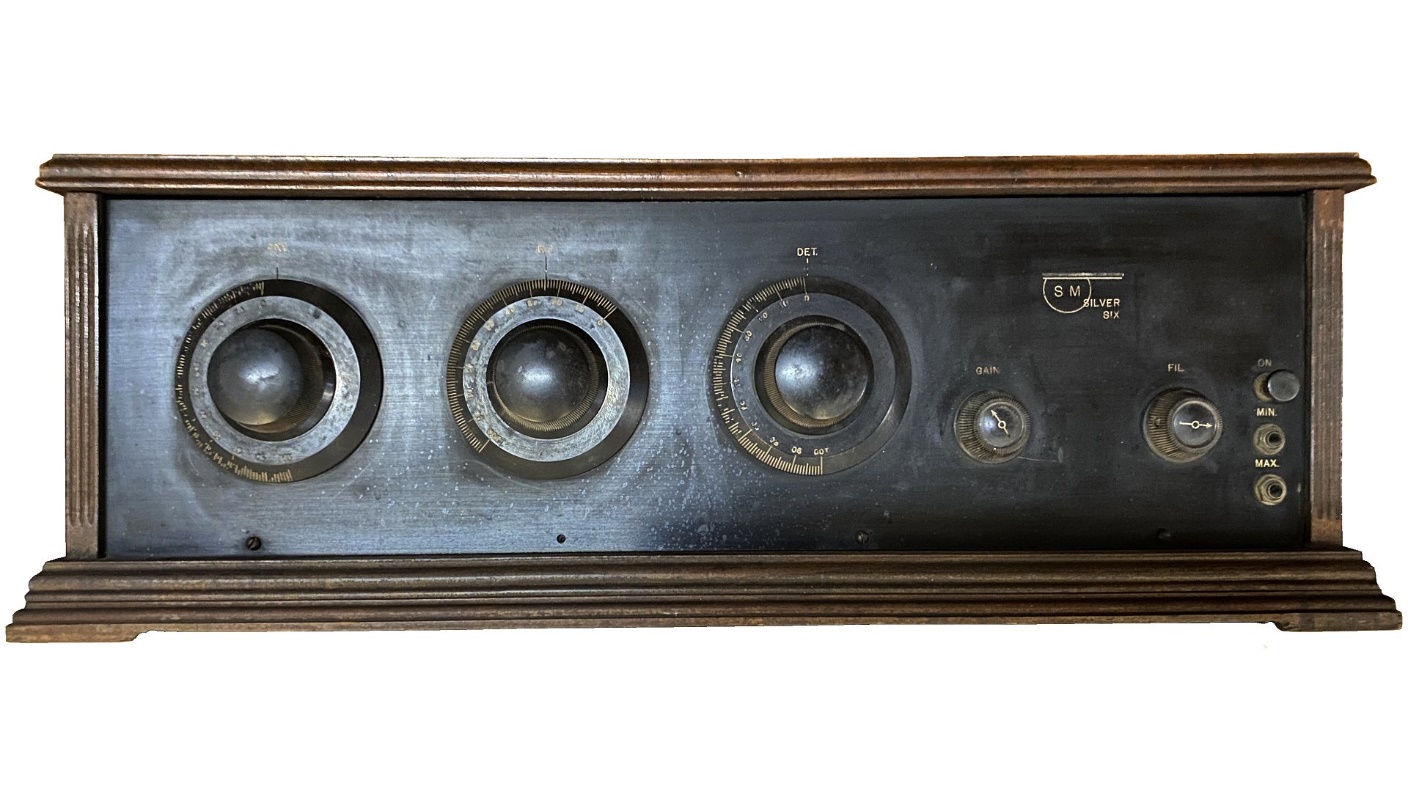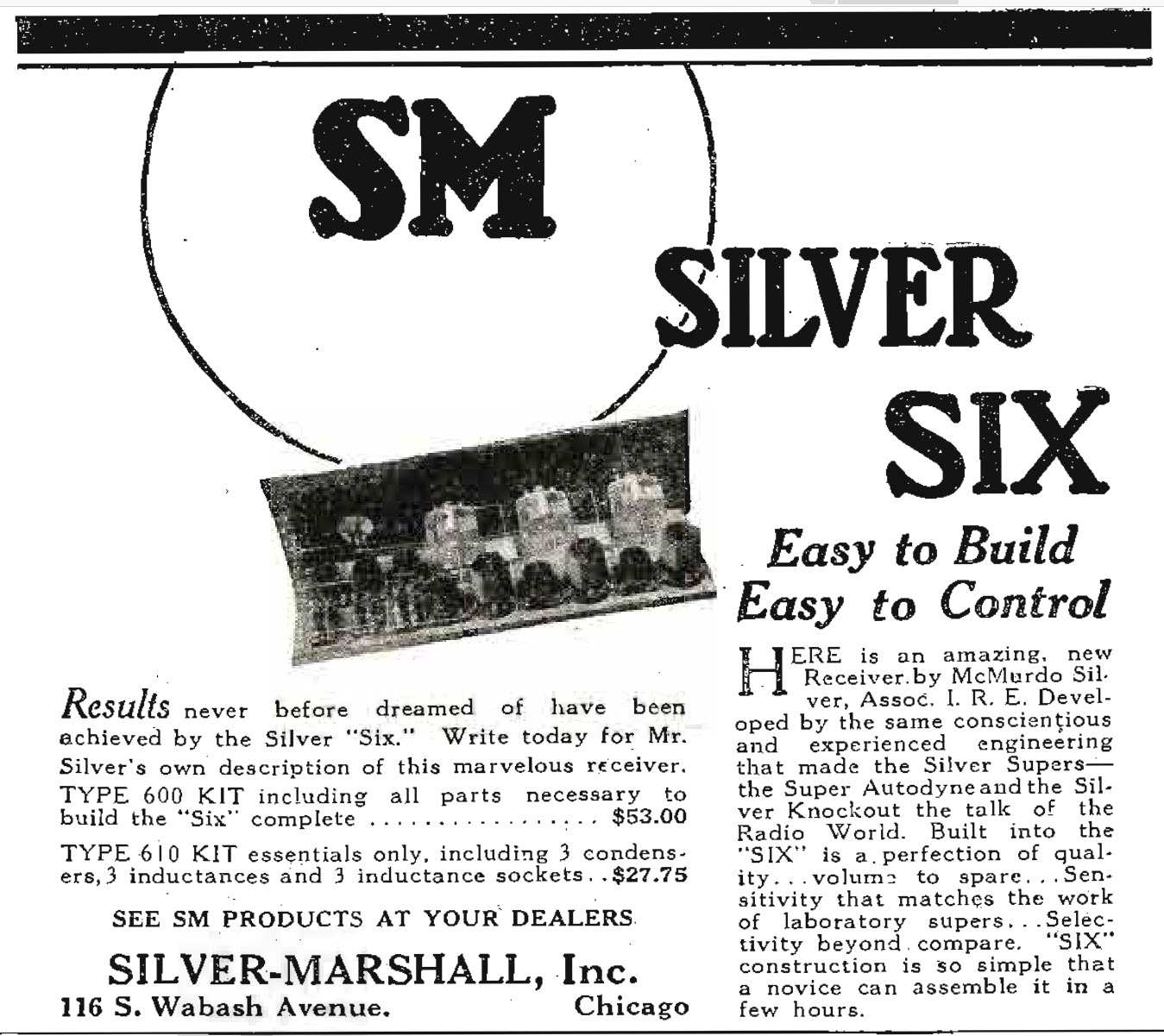
McMURDO SILVER started Silver-Marshall, Inc., with his cousin John Marshall in 1924. Before long they were selling parts for customers to build their own superheterodyne radios. At the time, RCA held the patents on the superheterodyne circuit and refused to license other manufacturers to use the patents to build complete radios.
In late 1925, Silver (then only 22 years old) began to offer a six tube TRF radio in kit form, the Silver Six. The Silver Six was a little unusual for the time in that it did not use audio transformers in its audio amplifying stages. Instead, it utilized a circuit in each audio stage known as resistance coupling. A resistor was connected between the plate of the previous stage and B+, with another resistor connected between the grid of the next stage and B-. A capacitor was placed between the plate of the previous stage and the grid of the next stage, which provided the necessary coupling between stages.
Around the same time as the Silver Six came onto the market, the UX-240 audio tube had been developed to take advantage of resistance-coupled audio amplifier circuits. The UX-240 had an amplification factor of 30 compared to the older, more common UX-201-A with its amplification factor of 8.
The Silver Six utilizes the then new UX type tube sockets, which were a great improvement over the older style UV sockets. The UV sockets required the tube base to be provided with a bayonet pin on one side. To install a tube into a UV socket, the tube bad to be rotated so its bayonet pin would go into the slot provided for the purpose in the socket, and then the tube was twisted slightly clockwise to lock it in place. Contacts on the bottom of each pin connected the tube pins into the radio’s circuitry.

An advertisement for the Silver Six from the December 1925 issue of Radio News magazine.
With UX sockets, it was a simple matter of plugging the tube into the socket. Two of the pins were made larger so the tube could only fit into the socket one way.
Other than the resistance-coupled audio circuitry, the Silver Six appears to be a conventional TRF (Tuned Radio Frequency) type of radio. Most radios of the mid-1920s utilized the TRF circuit, or an improved version of the same circuit known as the Neutrodyne. This was done since RCA held a firm grip on the superheterodyne patents. The Neutrodyne circuit was patented, and Hazeltine Corporation (owners of the Neutrodyne patent) licensed manufacturers to use it. But it appears that the basic TRF circuit had no such patent restrictions, and as a result, literally hundreds of radio companies sprang up during the early to middle 1920s. Most of these companies were quite small, some being literally kitchen table operations, and did not remain in business very long.
The Silver Six is a very large battery-operated radio. Part of the reason for its larger than average size is due to the fact that it uses six tubes instead of the five used by most average TRF or Neutrodyne radios of the period.
I had the opportunity to acquire this radio around four years ago from a collector in New Jersey. Unfortunately, due to the cancer, it turned out that I would not be able to return to Kutztown to pick up this radio. Thanks to the kindness of a few other collectors, this Silver Six finally made its way to me here in Indiana by way of the Philadelphia area.
I find this radio to be quite fascinating, as it is one of McMurdo Silver’s earlier radio models. I also own one of the last radios he ever produced – a Masterpiece VI. So now, in a way, I feel that I have “bookends” of Silver’s radio career.
Now here is a very brief history of Silver-Marshall and McMurdo Silver from the late 1920s on:
Silver-Marshall grew throughout the 1920s, adding more parts and kits to its lineup. The company entered the business of manufacturing large console radios which operated from AC power at the end of the decade. This proved to be disastrous due to the stock market crash of October 1929, which resulted in the Great Depression.
Silver-Marshall held on until 1932 when they went bankrupt. Young McMurdo Silver then started a new radio company, McMurdo Silver, Inc., and began to produce his Masterpiece series of high-end radios to compete with custom radio builder E.H. Scott.
Unfortunately, this venture, too, was destined for failure. After Silver built and marketed his Masterpiece VI in 1937-38, this company also went bankrupt. The assets of the firm were purchased by E.H. Scott who then produced a stripped-down Masterpiece under the Scott name.
McMurdo Silver would spend the next several years working for other electronics companies, trying again with his own company soon after World War II ended. His new McMurdo Silver Company produced test equipment and some ham radio gear.
The story of McMurdo Silver ended in 1948 when he committed suicide. He was only 45 years old.
But the radios he produced during his lifetime are still quite fascinating, as well as highly collectible.